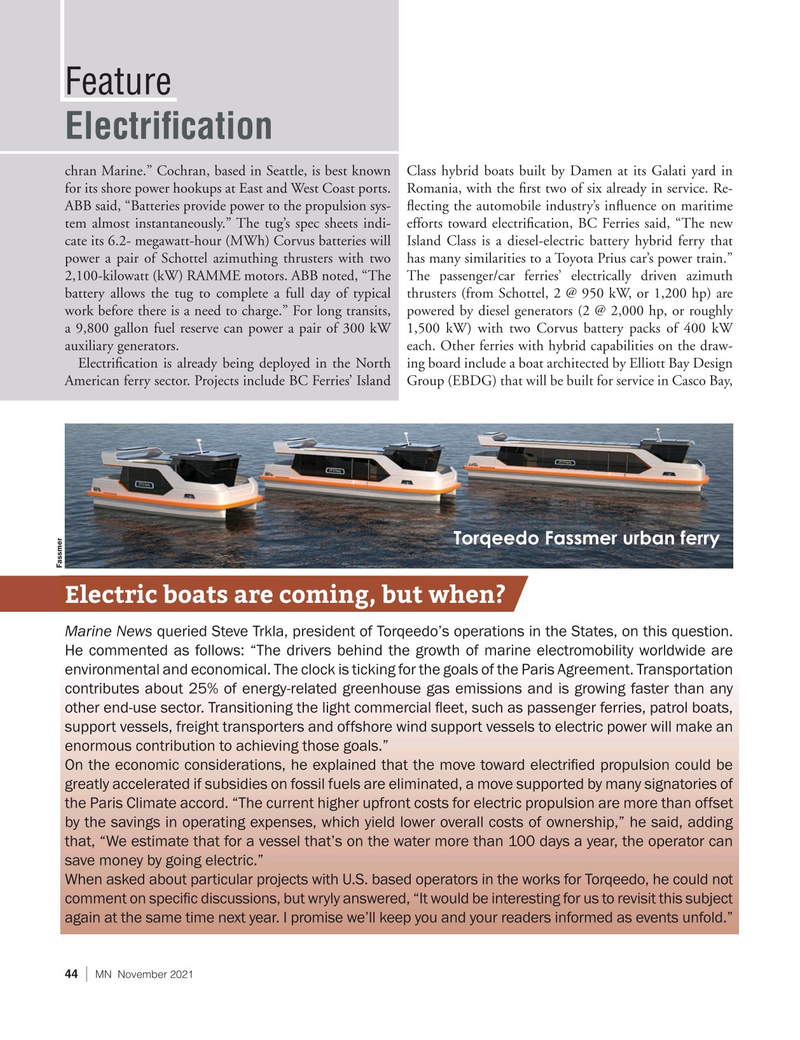
Page 44: of Marine News Magazine (November 2021)
Great Workboats of 2021
Read this page in Pdf, Flash or Html5 edition of November 2021 Marine News Magazine
Feature
Electri? cation chran Marine.” Cochran, based in Seattle, is best known Class hybrid boats built by Damen at its Galati yard in for its shore power hookups at East and West Coast ports. Romania, with the ? rst two of six already in service. Re-
ABB said, “Batteries provide power to the propulsion sys- ? ecting the automobile industry’s in? uence on maritime tem almost instantaneously.” The tug’s spec sheets indi- efforts toward electri? cation, BC Ferries said, “The new cate its 6.2- megawatt-hour (MWh) Corvus batteries will Island Class is a diesel-electric battery hybrid ferry that power a pair of Schottel azimuthing thrusters with two has many similarities to a Toyota Prius car’s power train.” 2,100-kilowatt (kW) RAMME motors. ABB noted, “The The passenger/car ferries’ electrically driven azimuth battery allows the tug to complete a full day of typical thrusters (from Schottel, 2 @ 950 kW, or 1,200 hp) are work before there is a need to charge.” For long transits, powered by diesel generators (2 @ 2,000 hp, or roughly a 9,800 gallon fuel reserve can power a pair of 300 kW 1,500 kW) with two Corvus battery packs of 400 kW auxiliary generators. each. Other ferries with hybrid capabilities on the draw-
Electri? cation is already being deployed in the North ing board include a boat architected by Elliott Bay Design
American ferry sector. Projects include BC Ferries’ Island Group (EBDG) that will be built for service in Casco Bay,
Torqeedo Fassmer urban ferry
Fassmer
Electric boats are coming, but when?
Marine News queried Steve Trkla, president of Torqeedo’s operations in the States, on this question.
He commented as follows: “The drivers behind the growth of marine electromobility worldwide are environmental and economical. The clock is ticking for the goals of the Paris Agreement. Transportation contributes about 25% of energy-related greenhouse gas emissions and is growing faster than any other end-use sector. Transitioning the light commercial ? eet, such as passenger ferries, patrol boats, support vessels, freight transporters and offshore wind support vessels to electric power will make an enormous contribution to achieving those goals.”
On the economic considerations, he explained that the move toward electri? ed propulsion could be greatly accelerated if subsidies on fossil fuels are eliminated, a move supported by many signatories of the Paris Climate accord. “The current higher upfront costs for electric propulsion are more than offset by the savings in operating expenses, which yield lower overall costs of ownership,” he said, adding that, “We estimate that for a vessel that’s on the water more than 100 days a year, the operator can save money by going electric.”
When asked about particular projects with U.S. based operators in the works for Torqeedo, he could not comment on speci? c discussions, but wryly answered, “It would be interesting for us to revisit this subject again at the same time next year. I promise we’ll keep you and your readers informed as events unfold.” 44 | MN November 2021

 43
43

 45
45
